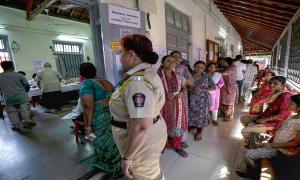India's two busiest airports -- Mumbai and Delhi -- face a new threat. Pressure is building to scrap the plan for modernising and upgrading the capacity of both these airports.
The government is close to awarding the contract to private parties, which will take a minority stake in newly formed joint ventures to modernise the airports, upgrade their capacity and then run them.
But this process may get delayed and eventually jettisoned by a new demand, raised by none else than the Left. And the demand is that instead of just increasing the existing capacity, the government should set up greenfield airports in Delhi and Mumbai.
How preposterous this demand is and how counter-productive this might be can easily be understood by looking at the basic data on air traffic and current infrastructure bottlenecks that afflict the two major airports.
The Delhi airport at present sees 117,000 aircraft movements in a year and carries a load of 11.2 million passengers. For the Mumbai airport, the figures for annual aircraft movements and passenger load are 150,000 and 14 million, respectively.
According to the government's own projections, the passenger load in Delhi and Mumbai will go up to 43 million and 52 million, respectively, by 2024. Annual aircraft movements too are expected to go up to 400,000 and 500,000, respectively.
The plan for modernising and upgrading the capacity at the two airports, estimated to cost about Rs 14,000 crore (Rs 140 billion), is to meet this higher traffic movements and passenger-handling targets.
But the Left parties, led by Nilotpal Basu of the CPI-M, have questioned the logic of such modernisation on the grounds that the plan does not envisage the addition of a new runway in Mumbai and therefore future growth will always remain limited.
Delhi has scope for a new runway, but even here Mr Basu, as the head of the parliamentary standing committee that went into this question, feels that the current airport in the Capital will be constrained by its existing physical space limitations to meet long-term growth targets.
Hence, some investment to augment the existing capacity may be made for the two airports, but the real solution for the future lies in the setting up of two greenfield airports.
The net impact of this proposal, if accepted by the government under Left pressure, will be disastrous for airport infrastructure in this country. Private investors, keen on participating in the new ventures to modernise the airports, will now have second thoughts.
International experience shows that a city can afford more than one large airport only if its annual passenger-handling requirement is over 50 million. In the case of Delhi or Mumbai, that figure of 50 million annual passengers will be reached only by 2024.
So, new investors in a greenfield airport will be wary to block their resources, unless they are assured (like those who invested in the new airport projects in Bangalore and Hyderabad) that the existing airports will be closed down once the new airports start operations.
And if such an assurance is indeed given, then the Left will complain that why the government is not allowing competition to take place, little realising that competition is feasible only when a viable market exists.
So, the upshot of this new Left demand will be further delay in the much-needed modernisation and capacity increase in the two airports. It is unfortunate that specious arguments like the lack of land for a new runway are being cited to stall the ongoing modernisation scheme.
In any case, the Delhi airport has adequate land to provide for a new runway. And if the Mumbai airport needs a new runway, the government can surely put some pressure on the state authorities to recover the land that rightfully belongs to the Airport Authority of India but has been encroached upon.
More than 170 acres of land near the Mumbai airport cannot be used by the Airport Authority of India because of illegal encroachments. Recovery of this land by relocating the existing illegal occupants to some other areas surely can provide land for a new runway.
Also, the use of new technology can ensure an increase in the hourly aircraft movements. Till last year, the Mumbai and Delhi airports could accommodate 25 aircraft movements in an hour. This, it has gone up to 30 and the goal is to raise it to 45 by 2024, which will enable these two airports to handle close to 50 million passengers a year.
It is clear that if only the government is focused on the need to recover the land that belongs to the Airport Authority of India in Mumbai and use technology to increase hourly aircraft movements, the doubts over the long-term growth potential of the two airports will disappear. And that should be a strong argument in favour of expediting the airport modernisation projection that is under way.
The country needs better airports and the best way to begin is to modernise and upgrade the capacity of those that already exist. The talk about greenfield airport projects in Delhi and Mumbai is nothing but an attempt to sidetrack the main issue of providing more safety and better passenger facilities for the rapidly growing air passengers of this country.









More from rediff